(Total Views: 398)
Posted On: 11/13/2023 9:59:51 AM
Post# of 394
EV Revolution in UK ............................................
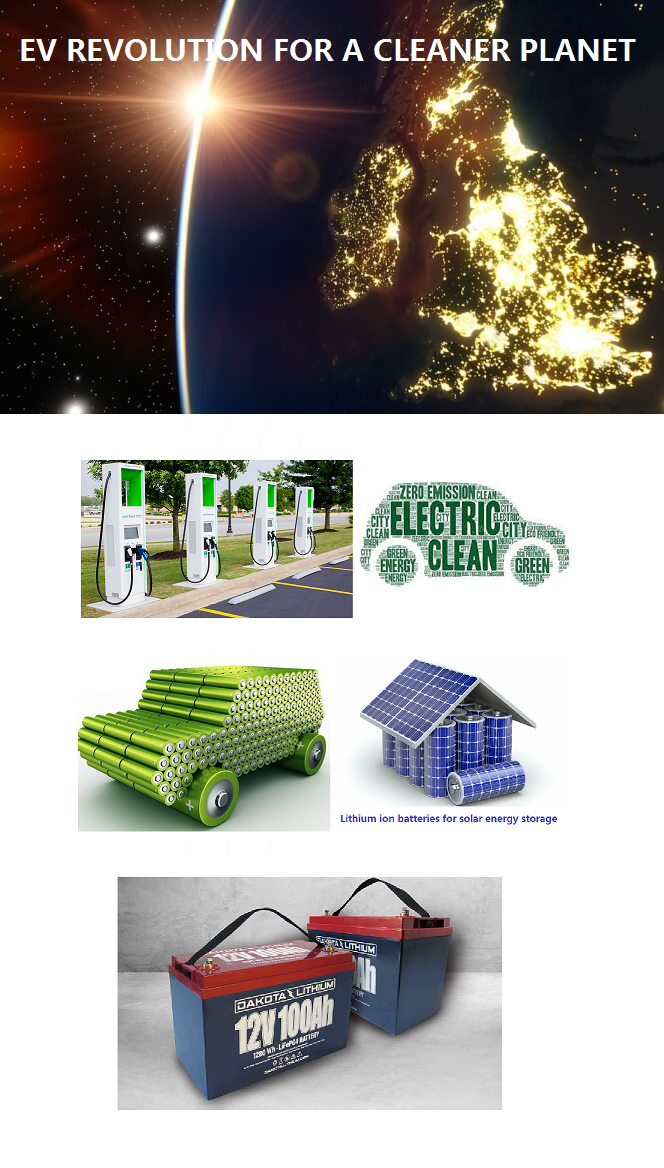
UK petrol and diesel car ban delayed to 2035
https://www.autoexpress.co.uk/tips-advice/108...e-affected
UK to host Minerals Security Partnership for first time to boost investment in critical minerals
https://www.ukpol.co.uk/press-release-uk-to-h...ober-2023/
Researchers in UK have produced a chemical known as lithium carbonate from rocks found in Cornwall and Scotland, lithium carbonate is used in lithium-ion batteries. Lithium compounds, minerals and salts naturally occur on almost every continent but is largely commercially mined in South America and Australia, before being shipped to China for processing into battery-grade lithium chemicals then lithium ion batteries. Finally, batteries are sent to Europe to be installed in electric vehicles. It is the high environmental cost, mining cost and the shipping cost that hinder the economic development in the EV industry in UK. Producing lithium domestically in UK will mitigate dependence on foreign countries. Lithium will be sourced from UK hard-rock raw materials, extracted and processed into lithium concentrate then ended with the production of "Made in UK" lithium batteries.
Imerys and British Lithium announce a strategic partnership to accelerate development of UK’s largest lithium deposit. The lithium mine in Cornwall will power two-third of UK's electric vehicles in 2030. British Lithium is a private company, Imerys is a public French mining company listed in the Paris Stock Exchange with current share price at 25 Euro (Canadian $37) and a market capitalization of 2 billion Euro. ( https://finance.yahoo.com/quote/NK.PA/ )
https://www.imerys.com/media-room/press-relea...accelerate
https://www.youtube.com/watch?v=anS74i1kO-s&t=252s
UK's First Large-Scale Lithium Refinery to be Built in Cornwall, Imerys British Lithium is on track to become Europe’s first commercial battery-grade lithium carbonate producer
https://imerysbritishlithium.com/joint-venture/
Global Battery Metals Reports High Grade Lithium Assays Returned; Surface Samples Up to 3.75% Li2O From NW Leinster Lithium Project
https://gbml.ca/news-releases/global-battery-...r-lithium/
Global Battery Metals Announces Lithium Pegmatite Dike Swarm Drilled at the Leinster Lithium Project in Ireland
https://www.nasdaq.com/press-release/global-b...e-leinster
Will southeast Ireland be Europe’s next lithium district?
https://themarketherald.ca/will-southeast-ire...023-07-04/
If GBML and Ganfeng Lithium prove lithium deposit in Leinster will be commercially viable, the province of Leinster in Ireland will host UK's second lithium mine and will supply the other one-third of UK's future lithium need. According to CEO Michael Murphy's anticipation, 10% of the lithium resources in Leister will retain in UK while 90% will be delivered to Europe to sustain the need of European Union.
CEO Michael Murphy's operating goal is to achieve a buyout deal with a major mining company. Very likely GBML will be bought out by Gangfeng which will conduct the mining development. Michael Murphy is very excited about Gangeng's exploration adjacent to GBML, he could be brushing up on Mandarin Chinese for better and more cordial communication with the Gangfeng management. Buyout offer price is usually based on share price at that time plus a premium and share price in turn depends on the competence of Murphy and his geologists in assembling a high tonnage of average grade lithium in his project. Unlike in gold discovery where high grade gold is significant, lithium oxide grade occurred in pegmatites usually ranges from under 1% to 6%, so lithium grade is insignificant but tonnage is, for only high tonnage resources/reserves is commercially and economically viable.
Quote from Imerys British Lithium's website: "Lithium resources in the Cornwall lithium mine is 161 million tonnes at a grade of 0.54 % lithium oxide. These resources give sufficient confidence to target a life of mine exceeding 30 years at a production rate of 20,000 tonnes of lithium carbonate equivalent per year, potentially enough to equip 500,000 electrical vehicles per year, by the end of the decade, meeting roughly two-thirds of Britain’s estimated battery demand by 2030 when all UK car manufacturers convert to electric vehicles".
Ganfeng Lithium has a market capitalization of 79 billion Chinese Yuan (Canadian $14.8 billion) and a total debt of under US$3 billion. It holds high-quality mineral resources in Australia, Argentina, Mexico and in China. Its revenue is growing at 11.3% annually.
British Lithium Video - From exploration to mining, to lithium extraction and to lithium battery giga factory plant
https://imerysbritishlithium.com/videos/
Another private mining company operating in Cornwall is Cornish Lithium:
Cornish lithium mine gets £54 million in new backing
https://ca.style.yahoo.com/cornish-lithium-mi...33323.html
Cornish Lithium Video
https://cornishlithium.com/news-and-media/videos/
History of mining in Cornwall
https://www.globevale.co.uk/blog/cornwall-a-h...%20century.
Cornish miners started their epic journey out of Cornwall, spreaded and disseminated mining technology around the world
https://www.cornishmining.org.uk/about/mining...-the-globe
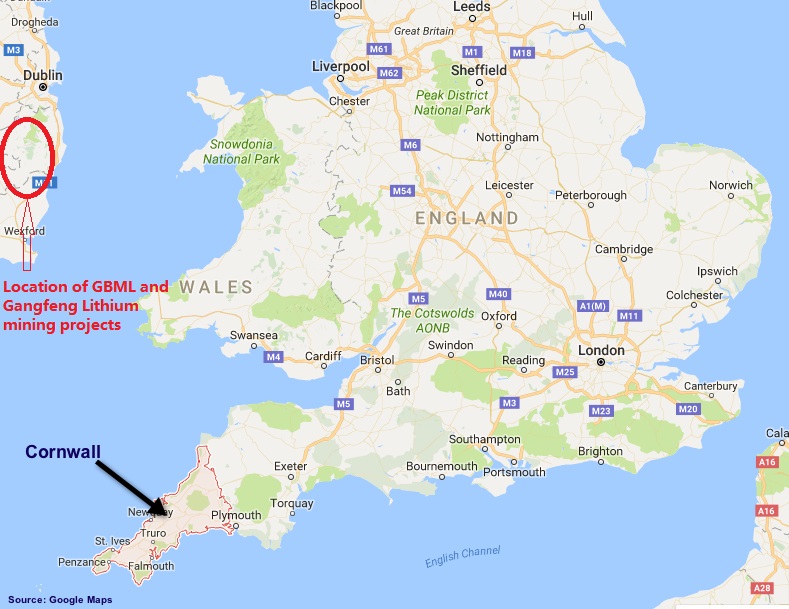
https://investorshangout.com/images/MYImages/...ummine.jpg
Aerial view of lithium mines located at 10Km northeast of Cornwall
https://www.google.ca/maps/dir/Cornwall/Devon...?entry=ttu
Zoom in view
https://www.google.ca/maps/search/British+Lit...?entry=ttu
Aerial view of PLA 1597 where rock samples with lithium oxide grade as high as 3.75% and swarms of lithium bearing pegmatites are discovered by GBML. The land stretching from the Southern Block to the Northern Block could become UK's second producing lithium mine in the year 2030, 5 times as big as the Cornwall lithium mines and with lithium oxide grade 5 times higher than the Cornwall's lithium oxide grade of 0.5%.
https://www.google.ca/maps/place/Carriglead,+...?entry=ttu
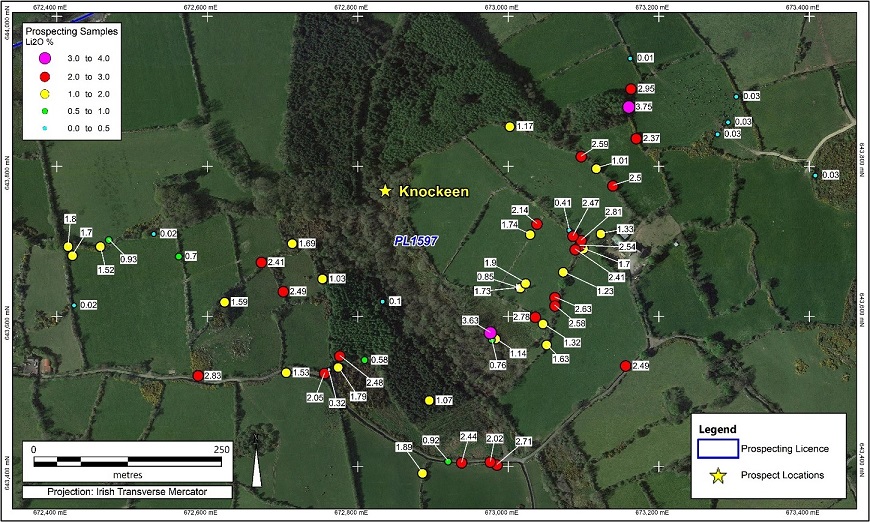
https://investorshangout.com/images/MYImages/...llsite.jpg
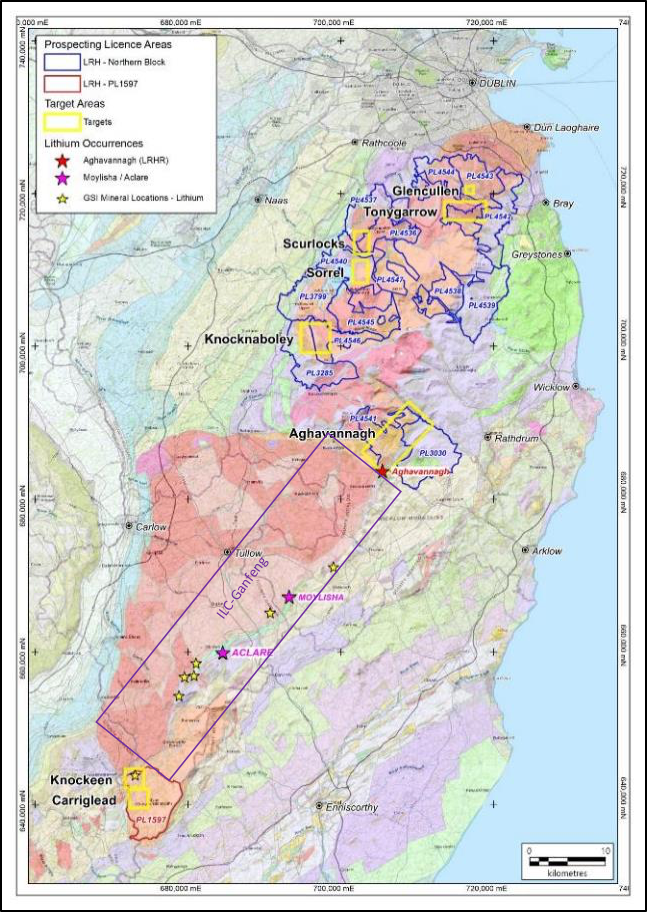
https://investorshangout.com/images/MYImages/...erties.png
~~~~~~~~~~~~~~~~~~~~~~~~~~
The Periodic Table
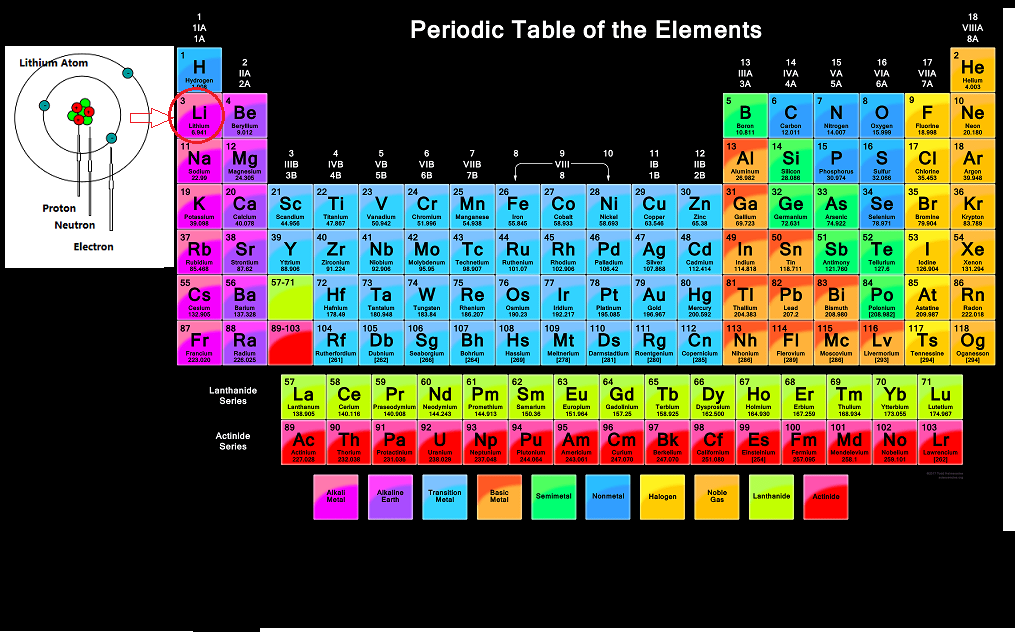
https://investorshangout.com/images/MYImages/...cTable.png
Chemistry of Lithium
Lithium is an alkali metal with the atomic number = 3 and an atomic mass of 6.941 grams/mole. This means that lithium has 3 protons, 3 electrons and 4 neutrons (6.941 - 3 = ~4). One mole contains 6.022 x 10 to the power 23 atoms.
https://chem.libretexts.org/Bookshelves/Inorg...203%20%3D%
Youtube Video - Chemical reaction between lithium and water
Lithium reacts violently with water, producing hydrogen gas, which bubbles out of the solution. The reaction is exothermic, which means it releases heat. The reaction between lithium and water produces lithium hydroxide (LiOH) and hydrogen gas (H2).
2Li + 2H2O = 2LIOH + H2
https://www.youtube.com/watch?v=Vxqe_ZOwsHs
Potassium, sodium, calcium and magnesium also react violently with water, but not aluminium, zinc, iron, copper silver and gold. Gold has the least reactivity in nature, that is why solid shiny gold is found in rocks. The order in decreasing reactivity is K, Na, Li, Ca, Mg, Al, Zn, Fe, Cu, Ag, Au.
Lithium ion batteries versus sodium ion batteries
https://www.dnkpower.com/will-sodium-batterie...%20storage
https://batteriesnews.com/sodium-ion-batterie...ast%20year
Contemporary Amperex Technology Co., Limited (CATL), a global leader in lithium-ion battery development and manufacturing, is committed to providing premier solutions and services for new energy applications worldwide.
https://www.catl.com/en/
Pegmatite and spodumene
What is pegmatite
Pegmatite is a common plutonic rock, of variable texture and coarseness, that is composed of interlocking crystals of widely different sizes. The most spectacular pegmatites contain abnormally large crystals mixed with medium and smaller crystals. Crystals up to many meters long have been reported. Some pegmatite may be thousands of meters in length and hundreds of meters thick, some appear as dikes, veins, or sills. Pegmatites may be composed of a variety of minerals. Terms such as spodumene pegmatite, granite pegmatite, gabbro pegmatite, syenite pegmatite.
Pegmatite is granite-like rock that isn’t very useful on its own but houses some very precious minerals and elements such as lithium, spodumene, cesium, rare earth elements, tantalum, niobium, and many gemstones including apatite, aquamarine, emerald, garnet, topaz, tourmaline, zircon, scapolite, beryl, apatite, fluorite and zircon. Gem quality stones and elements such as tungsten, boron, tantalum, columbium, bismuth, tin, uranium, radium, sheet mica, and sulfide minerals are found in pegmatite.
Images of Pegmatite
https://www.google.ca/search?sxsrf=AJOqlzXZec...&dpr=1
Pegmatite dyke
https://epod.usra.edu/blog/2010/04/pegmatite-...%20Pangaea
What is spodumene
Spodumene is a pyroxene mineral consisting of lithium aluminium inosilicate ( Chemical formula LiAl(SiO3)2 or LIAlSi2O6 ), it is a source of lithium. It occurs as colorless to yellowish, purplish, or lilac kunzite, yellowish-green or emerald-green hiddenite, prismatic crystals, often of great size. Single crystals of 14.3 m (47 ft) in size are reported.
https://en.wikipedia.org/wiki/Spodumene
Images of spodumene
https://www.google.ca/search?sxsrf=AJOqlzWku7...&dpr=1
Spodumene pegmatite is plutonic rock with spodumene embedded in it.
Image of spodumene pegmatite
https://www.google.ca/search?q=spodumene+pegm...p;biw=1024
~~~~~~~~~~~~~~~~~~~~~~~~~~~~~~~~~~~~~~~~~~~~~~~~~~~
How does lithium batteries work
https://letstalkscience.ca/educational-resour...ercalation.
Lithium is an element which has many applications. It is mined from ores of petalite LiAl(Si2O5)2, lepidolite K(Li,Al)3(Al,Si,Rb)4O10(F,OH)2, spodumene LiAl(SiO3)2 and also subsurface brines. Lithium is chemically extremely active, so it cannot be used in metallic form, instead, lithium carbonate or lithium hydroxide is used as base compound. The most common materials used in lithium-ion batteries cathode (positive electrode) include lithium cobalt oxide (LiCoO2), lithium manganese oxide (LiMn2O4), lithium iron phosphate (LiFePO4 or LFP), and lithium nickel manganese cobalt oxide (LiNiMnCoO2 or NMC). That is why colbalt, manganese and nickel are also in the Critical Minerals list. The anode (negative electrode) is typically made up of Graphite, coated on Copper Foil. As the lithium-metal-oxide supplies the lithium-ions, the batteries are called lithium-ion batteries.
Lithium hardrock mining vs lithium brine mining
https://www.minersdata.com/lithium-hard-rock-...ne-mining/
Lithium hardrock mining: Lithium oxide (Li2O) is extracted from ores then converted into lithium carbonate or lithium hydroxide.
Lithium brine mining: Brine contains dissolved lithium salts formed in rocks over millions of years or obtained through solar evaporation or mechanical evaporation. The concentrated brine is then further processed to extract lithium carbonate or lithium hydroxide.
Lithium carbonate (LI2CO3)
https://en.wikipedia.org/wiki/Lithium_carbona...vaporation.
Lithium hydroxide (LIOH)
https://en.wikipedia.org/wiki/Lithium_hydroxide
Lithium carbonate (Li2CO3) vs lithium hydroxide (LiOH)
https://bisleyinternational.com/what-is-the-d...hydroxide/
~~~~~~~~~~~~~~~~~~~~~~~~~~~~~~~~~~~~~~
Why James Bay, Ireland and Newfoundland have similar spodumene pegmatites
The area’s granitic rock from the Paleozoic era is part of a larger Appalachian-Caledonian belt that extends from the Ireland and the UK, through Newfoundland and into the eastern US. Included in this suture zone are the important lithium deposits held by Ganfeng Lithium/International Lithium Corp. Blackstairs Lithium Project in Ireland, as well as by Piedmont Lithium Inc. in the Carolinas, US.
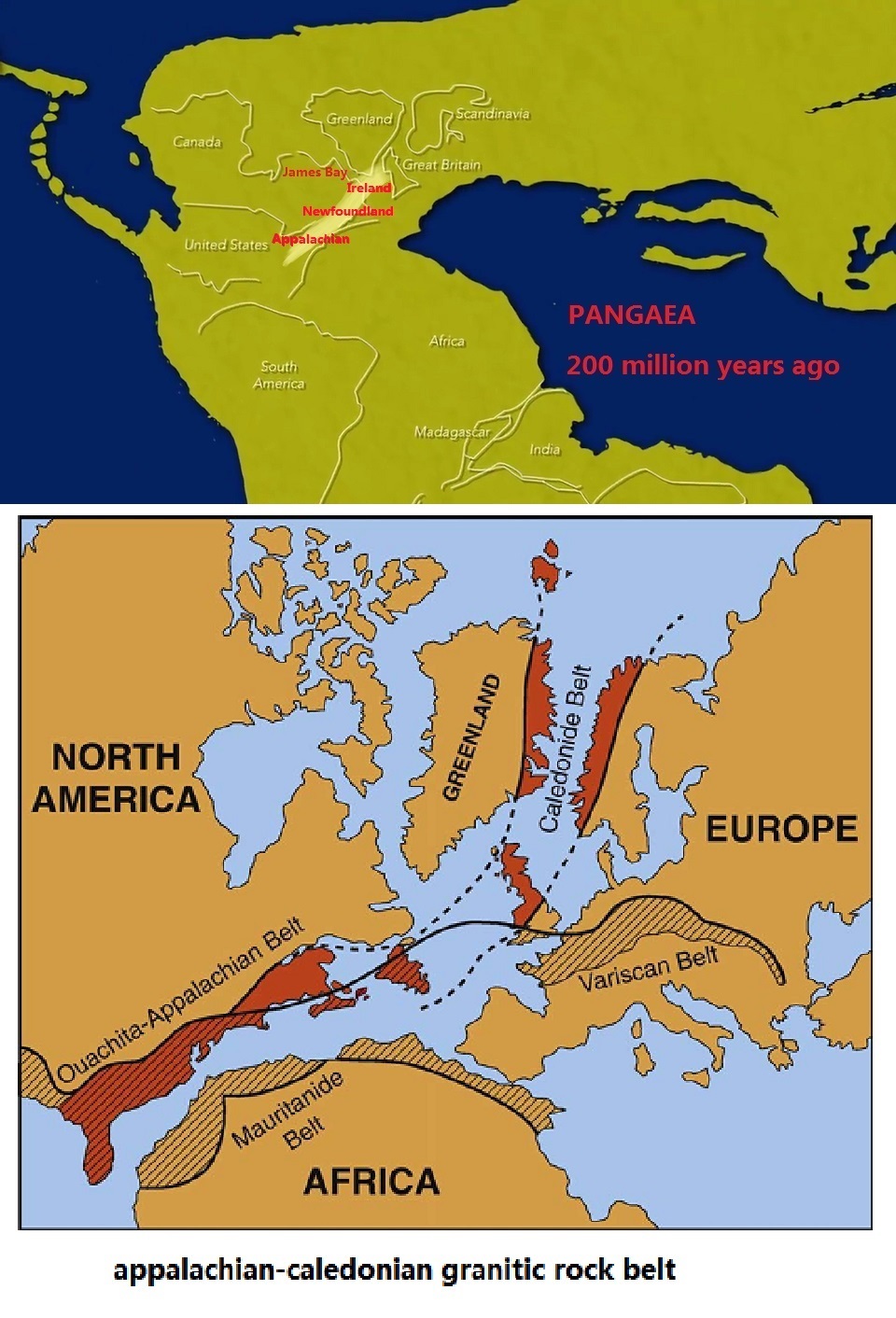
https://investorshangout.com/images/MYImages/...ckbelt.jpg
How continents, hardrock lithium were formed
About 300-200 million years ago the continent we now know as North America was contiguous with Africa, South America, and Europe. Canada's James Bay, Greenland, Newfoundland and Great Britain were once contiguous. They all existed as a single continent called Pangaea. Magma from the interior of the Earth carrying precious and base metals protruded into the Earth's crust forming pegmatites. Since lithium is chemically very active, elemental lithium does not exists, rather, it formed numerous lithium minerals, lithium salts and lithium compounds. Mineral such as spodumene found in pegmatites is a pyroxene mineral consisting of lithium aluminium inosilicate (chemical formula LiAl2SiO6). As the Pangaea splitted into continents and as continents gradually drifted far apart, those spodumene pegmatites were distributed all around the world, but the characteristics and signatures of their existence remain the same anywhere they are found. As Pangaea broke up, Europe started drifting away from North America, taking the lithium mineralizations with it and deposited along the stretched Appalachian-Caledonian granitic rock belt. Newfoundland is not just an island filled with fishing ports, it may be hidden with LCT pegmatite and spodumene pegmatite similar to that in Ireland with long intervals of 3.75% lithium, waiting to be discovered while Ireland still has the potential of hosting PMET style multiple LCT/Spodumene pegmatites with long intervals of high grade lithium.
Drill core assays of Sokoman-Benton joint venture's Golden Hope project, Newfoundland
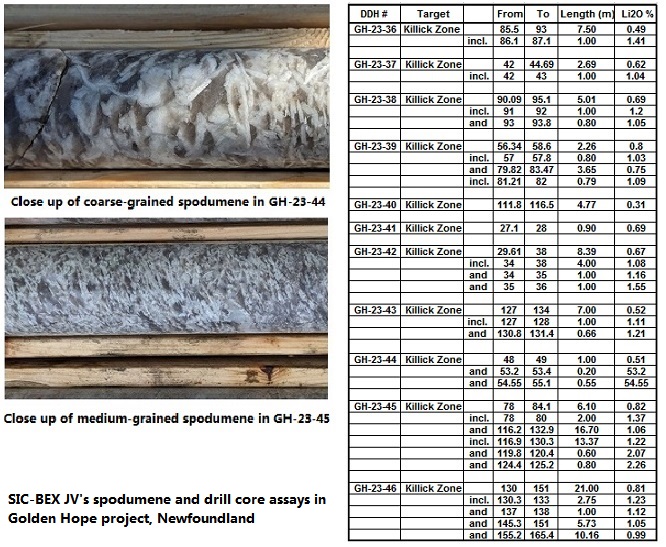
https://investorshangout.com/images/MYImages/...-23-45.jpg
Drill core assays of Patriot Battery Metals in James Bay, Quebec
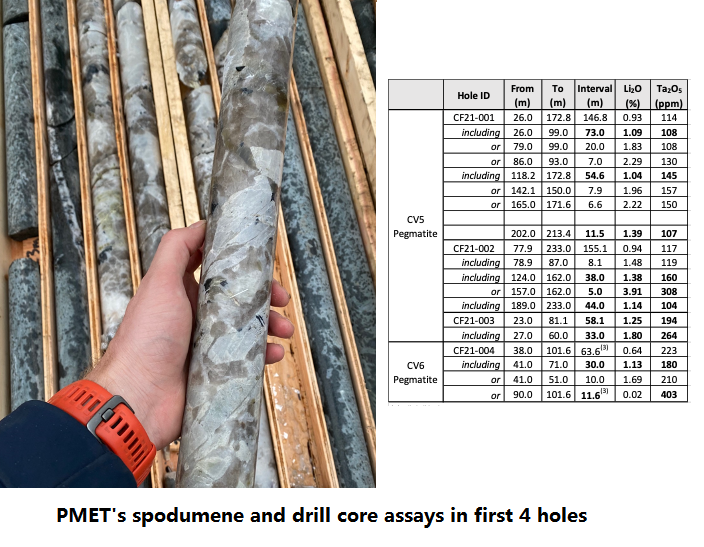
https://investorshangout.com/images/MYImages/...4holes.png
Drill core assays of Global Battery Metals in Leinster, Ireland is pending
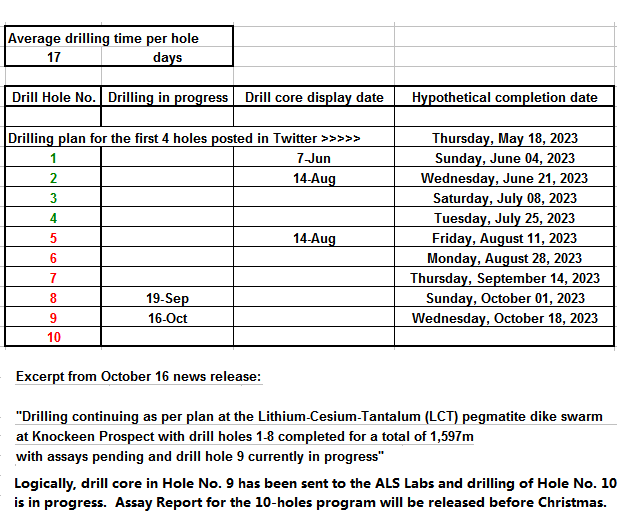
Display from Twitter.com:
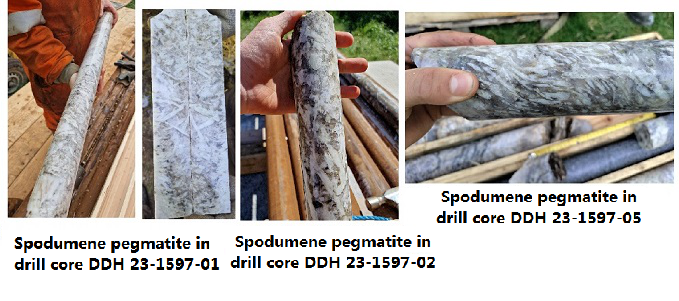
https://investorshangout.com/images/MYImages/...reland.png

UK petrol and diesel car ban delayed to 2035
https://www.autoexpress.co.uk/tips-advice/108...e-affected
UK to host Minerals Security Partnership for first time to boost investment in critical minerals
https://www.ukpol.co.uk/press-release-uk-to-h...ober-2023/
Researchers in UK have produced a chemical known as lithium carbonate from rocks found in Cornwall and Scotland, lithium carbonate is used in lithium-ion batteries. Lithium compounds, minerals and salts naturally occur on almost every continent but is largely commercially mined in South America and Australia, before being shipped to China for processing into battery-grade lithium chemicals then lithium ion batteries. Finally, batteries are sent to Europe to be installed in electric vehicles. It is the high environmental cost, mining cost and the shipping cost that hinder the economic development in the EV industry in UK. Producing lithium domestically in UK will mitigate dependence on foreign countries. Lithium will be sourced from UK hard-rock raw materials, extracted and processed into lithium concentrate then ended with the production of "Made in UK" lithium batteries.
Imerys and British Lithium announce a strategic partnership to accelerate development of UK’s largest lithium deposit. The lithium mine in Cornwall will power two-third of UK's electric vehicles in 2030. British Lithium is a private company, Imerys is a public French mining company listed in the Paris Stock Exchange with current share price at 25 Euro (Canadian $37) and a market capitalization of 2 billion Euro. ( https://finance.yahoo.com/quote/NK.PA/ )
https://www.imerys.com/media-room/press-relea...accelerate
https://www.youtube.com/watch?v=anS74i1kO-s&t=252s
UK's First Large-Scale Lithium Refinery to be Built in Cornwall, Imerys British Lithium is on track to become Europe’s first commercial battery-grade lithium carbonate producer
https://imerysbritishlithium.com/joint-venture/
Global Battery Metals Reports High Grade Lithium Assays Returned; Surface Samples Up to 3.75% Li2O From NW Leinster Lithium Project
https://gbml.ca/news-releases/global-battery-...r-lithium/
Global Battery Metals Announces Lithium Pegmatite Dike Swarm Drilled at the Leinster Lithium Project in Ireland
https://www.nasdaq.com/press-release/global-b...e-leinster
Will southeast Ireland be Europe’s next lithium district?
https://themarketherald.ca/will-southeast-ire...023-07-04/
If GBML and Ganfeng Lithium prove lithium deposit in Leinster will be commercially viable, the province of Leinster in Ireland will host UK's second lithium mine and will supply the other one-third of UK's future lithium need. According to CEO Michael Murphy's anticipation, 10% of the lithium resources in Leister will retain in UK while 90% will be delivered to Europe to sustain the need of European Union.
CEO Michael Murphy's operating goal is to achieve a buyout deal with a major mining company. Very likely GBML will be bought out by Gangfeng which will conduct the mining development. Michael Murphy is very excited about Gangeng's exploration adjacent to GBML, he could be brushing up on Mandarin Chinese for better and more cordial communication with the Gangfeng management. Buyout offer price is usually based on share price at that time plus a premium and share price in turn depends on the competence of Murphy and his geologists in assembling a high tonnage of average grade lithium in his project. Unlike in gold discovery where high grade gold is significant, lithium oxide grade occurred in pegmatites usually ranges from under 1% to 6%, so lithium grade is insignificant but tonnage is, for only high tonnage resources/reserves is commercially and economically viable.
Quote from Imerys British Lithium's website: "Lithium resources in the Cornwall lithium mine is 161 million tonnes at a grade of 0.54 % lithium oxide. These resources give sufficient confidence to target a life of mine exceeding 30 years at a production rate of 20,000 tonnes of lithium carbonate equivalent per year, potentially enough to equip 500,000 electrical vehicles per year, by the end of the decade, meeting roughly two-thirds of Britain’s estimated battery demand by 2030 when all UK car manufacturers convert to electric vehicles".
Ganfeng Lithium has a market capitalization of 79 billion Chinese Yuan (Canadian $14.8 billion) and a total debt of under US$3 billion. It holds high-quality mineral resources in Australia, Argentina, Mexico and in China. Its revenue is growing at 11.3% annually.
British Lithium Video - From exploration to mining, to lithium extraction and to lithium battery giga factory plant
https://imerysbritishlithium.com/videos/
Another private mining company operating in Cornwall is Cornish Lithium:
Cornish lithium mine gets £54 million in new backing
https://ca.style.yahoo.com/cornish-lithium-mi...33323.html
Cornish Lithium Video
https://cornishlithium.com/news-and-media/videos/
History of mining in Cornwall
https://www.globevale.co.uk/blog/cornwall-a-h...%20century.
Cornish miners started their epic journey out of Cornwall, spreaded and disseminated mining technology around the world
https://www.cornishmining.org.uk/about/mining...-the-globe

https://investorshangout.com/images/MYImages/...ummine.jpg
Aerial view of lithium mines located at 10Km northeast of Cornwall
https://www.google.ca/maps/dir/Cornwall/Devon...?entry=ttu
Zoom in view
https://www.google.ca/maps/search/British+Lit...?entry=ttu
Aerial view of PLA 1597 where rock samples with lithium oxide grade as high as 3.75% and swarms of lithium bearing pegmatites are discovered by GBML. The land stretching from the Southern Block to the Northern Block could become UK's second producing lithium mine in the year 2030, 5 times as big as the Cornwall lithium mines and with lithium oxide grade 5 times higher than the Cornwall's lithium oxide grade of 0.5%.
https://www.google.ca/maps/place/Carriglead,+...?entry=ttu

https://investorshangout.com/images/MYImages/...llsite.jpg

https://investorshangout.com/images/MYImages/...erties.png
~~~~~~~~~~~~~~~~~~~~~~~~~~
The Periodic Table

https://investorshangout.com/images/MYImages/...cTable.png
Chemistry of Lithium
Lithium is an alkali metal with the atomic number = 3 and an atomic mass of 6.941 grams/mole. This means that lithium has 3 protons, 3 electrons and 4 neutrons (6.941 - 3 = ~4). One mole contains 6.022 x 10 to the power 23 atoms.
https://chem.libretexts.org/Bookshelves/Inorg...203%20%3D%
Youtube Video - Chemical reaction between lithium and water
Lithium reacts violently with water, producing hydrogen gas, which bubbles out of the solution. The reaction is exothermic, which means it releases heat. The reaction between lithium and water produces lithium hydroxide (LiOH) and hydrogen gas (H2).
2Li + 2H2O = 2LIOH + H2
https://www.youtube.com/watch?v=Vxqe_ZOwsHs
Potassium, sodium, calcium and magnesium also react violently with water, but not aluminium, zinc, iron, copper silver and gold. Gold has the least reactivity in nature, that is why solid shiny gold is found in rocks. The order in decreasing reactivity is K, Na, Li, Ca, Mg, Al, Zn, Fe, Cu, Ag, Au.
Lithium ion batteries versus sodium ion batteries
https://www.dnkpower.com/will-sodium-batterie...%20storage
https://batteriesnews.com/sodium-ion-batterie...ast%20year
Contemporary Amperex Technology Co., Limited (CATL), a global leader in lithium-ion battery development and manufacturing, is committed to providing premier solutions and services for new energy applications worldwide.
https://www.catl.com/en/
Pegmatite and spodumene
What is pegmatite
Pegmatite is a common plutonic rock, of variable texture and coarseness, that is composed of interlocking crystals of widely different sizes. The most spectacular pegmatites contain abnormally large crystals mixed with medium and smaller crystals. Crystals up to many meters long have been reported. Some pegmatite may be thousands of meters in length and hundreds of meters thick, some appear as dikes, veins, or sills. Pegmatites may be composed of a variety of minerals. Terms such as spodumene pegmatite, granite pegmatite, gabbro pegmatite, syenite pegmatite.
Pegmatite is granite-like rock that isn’t very useful on its own but houses some very precious minerals and elements such as lithium, spodumene, cesium, rare earth elements, tantalum, niobium, and many gemstones including apatite, aquamarine, emerald, garnet, topaz, tourmaline, zircon, scapolite, beryl, apatite, fluorite and zircon. Gem quality stones and elements such as tungsten, boron, tantalum, columbium, bismuth, tin, uranium, radium, sheet mica, and sulfide minerals are found in pegmatite.
Images of Pegmatite
https://www.google.ca/search?sxsrf=AJOqlzXZec...&dpr=1
Pegmatite dyke
https://epod.usra.edu/blog/2010/04/pegmatite-...%20Pangaea
What is spodumene
Spodumene is a pyroxene mineral consisting of lithium aluminium inosilicate ( Chemical formula LiAl(SiO3)2 or LIAlSi2O6 ), it is a source of lithium. It occurs as colorless to yellowish, purplish, or lilac kunzite, yellowish-green or emerald-green hiddenite, prismatic crystals, often of great size. Single crystals of 14.3 m (47 ft) in size are reported.
https://en.wikipedia.org/wiki/Spodumene
Images of spodumene
https://www.google.ca/search?sxsrf=AJOqlzWku7...&dpr=1
Spodumene pegmatite is plutonic rock with spodumene embedded in it.
Image of spodumene pegmatite
https://www.google.ca/search?q=spodumene+pegm...p;biw=1024
~~~~~~~~~~~~~~~~~~~~~~~~~~~~~~~~~~~~~~~~~~~~~~~~~~~
How does lithium batteries work
https://letstalkscience.ca/educational-resour...ercalation.
Lithium is an element which has many applications. It is mined from ores of petalite LiAl(Si2O5)2, lepidolite K(Li,Al)3(Al,Si,Rb)4O10(F,OH)2, spodumene LiAl(SiO3)2 and also subsurface brines. Lithium is chemically extremely active, so it cannot be used in metallic form, instead, lithium carbonate or lithium hydroxide is used as base compound. The most common materials used in lithium-ion batteries cathode (positive electrode) include lithium cobalt oxide (LiCoO2), lithium manganese oxide (LiMn2O4), lithium iron phosphate (LiFePO4 or LFP), and lithium nickel manganese cobalt oxide (LiNiMnCoO2 or NMC). That is why colbalt, manganese and nickel are also in the Critical Minerals list. The anode (negative electrode) is typically made up of Graphite, coated on Copper Foil. As the lithium-metal-oxide supplies the lithium-ions, the batteries are called lithium-ion batteries.
Lithium hardrock mining vs lithium brine mining
https://www.minersdata.com/lithium-hard-rock-...ne-mining/
Lithium hardrock mining: Lithium oxide (Li2O) is extracted from ores then converted into lithium carbonate or lithium hydroxide.
Lithium brine mining: Brine contains dissolved lithium salts formed in rocks over millions of years or obtained through solar evaporation or mechanical evaporation. The concentrated brine is then further processed to extract lithium carbonate or lithium hydroxide.
Lithium carbonate (LI2CO3)
https://en.wikipedia.org/wiki/Lithium_carbona...vaporation.
Lithium hydroxide (LIOH)
https://en.wikipedia.org/wiki/Lithium_hydroxide
Lithium carbonate (Li2CO3) vs lithium hydroxide (LiOH)
https://bisleyinternational.com/what-is-the-d...hydroxide/
~~~~~~~~~~~~~~~~~~~~~~~~~~~~~~~~~~~~~~
Why James Bay, Ireland and Newfoundland have similar spodumene pegmatites
The area’s granitic rock from the Paleozoic era is part of a larger Appalachian-Caledonian belt that extends from the Ireland and the UK, through Newfoundland and into the eastern US. Included in this suture zone are the important lithium deposits held by Ganfeng Lithium/International Lithium Corp. Blackstairs Lithium Project in Ireland, as well as by Piedmont Lithium Inc. in the Carolinas, US.

https://investorshangout.com/images/MYImages/...ckbelt.jpg
How continents, hardrock lithium were formed
About 300-200 million years ago the continent we now know as North America was contiguous with Africa, South America, and Europe. Canada's James Bay, Greenland, Newfoundland and Great Britain were once contiguous. They all existed as a single continent called Pangaea. Magma from the interior of the Earth carrying precious and base metals protruded into the Earth's crust forming pegmatites. Since lithium is chemically very active, elemental lithium does not exists, rather, it formed numerous lithium minerals, lithium salts and lithium compounds. Mineral such as spodumene found in pegmatites is a pyroxene mineral consisting of lithium aluminium inosilicate (chemical formula LiAl2SiO6). As the Pangaea splitted into continents and as continents gradually drifted far apart, those spodumene pegmatites were distributed all around the world, but the characteristics and signatures of their existence remain the same anywhere they are found. As Pangaea broke up, Europe started drifting away from North America, taking the lithium mineralizations with it and deposited along the stretched Appalachian-Caledonian granitic rock belt. Newfoundland is not just an island filled with fishing ports, it may be hidden with LCT pegmatite and spodumene pegmatite similar to that in Ireland with long intervals of 3.75% lithium, waiting to be discovered while Ireland still has the potential of hosting PMET style multiple LCT/Spodumene pegmatites with long intervals of high grade lithium.
Drill core assays of Sokoman-Benton joint venture's Golden Hope project, Newfoundland

https://investorshangout.com/images/MYImages/...-23-45.jpg
Drill core assays of Patriot Battery Metals in James Bay, Quebec

https://investorshangout.com/images/MYImages/...4holes.png
Drill core assays of Global Battery Metals in Leinster, Ireland is pending

Display from Twitter.com:

https://investorshangout.com/images/MYImages/...reland.png
